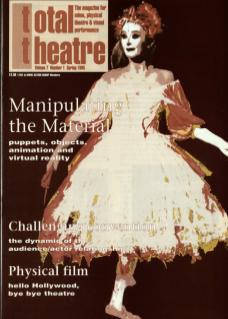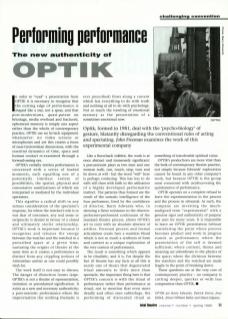In order to ‘read’ a presentation from Optik it is necessary to recognise that the cutting edge of performance is shaped like a star, not a spear, and that post-modernisms, quasi-patent on bricolage, media overload and fractured, ephemeral memory is simply one aspect rather than the whole of contemporary practice. Optik use no hi-tech equipment whatsoever: no video screens or microphones and yet this creates a focus of near-Grotowskian dimensions, with the essential dynamics of time, space and human contact reexamined through a forward-seeing eye.
Optik's verbally textless performance is concerned with a series of loaded moments, each equalling one of a potentially limitless variety of possibilities, the spatial, physical and connotative ramifications of which are interpreted or mediated by the individual spectators.
This signifies a radical shift in any serious consideration of the spectator's response, for where the watcher's role is or was that of consumer, any real sense or reciprocity is denied in favour of a closed and ultimately sterile relationship. Optik's work is important because it recognises and releases the energy between the watcher and the watched in a prescribed space at a given time, nurturing the origins of theatre at the same time as it creates a performance as distinct from any crippling notions of Aristotelian unities as one could possibly wish for.
The work itself is not easy to discuss. The danger of distortion looms large. Optik's is not a theatre of representation, imitation or preordained signification. It exists as a new and necessary authenticity; a post-semiotic performance where the improvisation (for nothing thematic is ever prescribed) flows along a current which has everything to do with truth and nothing at all to do with psychology. Not so much the trawling of emotional memory as the presentation of a sometimes emotional now.
Like a Rorschach inkblot, the work is at once abstract and immensely significant: a percussionist plays as two men and one woman walk, run, touch, stop, turn and lie down at will – but the word ‘will’ here is perhaps confusing. This has less to do with will than with faith in the utilisation of a highly developed performative instinct. The patterns thus formed are the result of the somatic intelligence of the four performers, freed by the confidence of director Barry Edwards who, in stressing a fierce resistance to the director-performer-performed continuum of the standard theatre process, allows Optik's art to exist with an absolute absence of artifice. Personal process and formal articulation create here a seamless blend which is not so much a synthesis of form and content as a unique exploration of the very context of performance.
The result is something which appears to be ritualistic, and it is. For despite the fact (if theatre has any facts at all this is surely one of them) that degenerated ritual amounts to little more than spectacle, the important thing here is that Optik's concern is with the ritual of performance rather than performance as ritual, not to mention that even more deadly and often seen subterfuge, the performing of dislocated ritual as something of transferable spiritual value.
Optik's productions are more vital than the bulk of contemporary theatre practice, not simply because Edwards' exploration cannot be found in any other company's work, but because Optik is the group most concerned with (re)discovering the quintessence of performance.
Optik operates on a complete refusal to leave the experimentation in the process and the process in rehearsal. As such, the company are investing the much-maligned term ‘experimental’ with a genuine rigour and authenticity of purpose not seen for many years. It is impossible to leave an Optik presentation without considering the point where process becomes product and work in progress stands as performance; where the presentation of the self is deemed sufficient; where content, theme and meaning are subordinate to the physics of the space; where the divisions between the watchers and the watched are made fragile to the point of breaking down.
These questions are at the very core of contemporary practice – no company is cutting deeper, quicker or with less compromise than Optik.
Optik are Barry Edwards, Patrick Driver, Jerry Killick, Alison William Bailey and Simon Edgoose.

